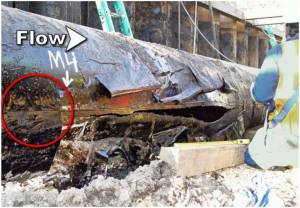For Ongoing Line 6B Updates – Line 6B Citizen’s Blog
On July 25th, 2010, Enbridge Inc. experienced the largest and most catastrophic spill in its company’s history. At 5:58pm, Line 6B in Marshall, Michigan ruptured into a wetland. The result would be over 3,000,000L of diluted bitumen (OilSands) gushing into the Kalamazoo River … undetected by Enbridge … for over 17 hours!
The National Transportation Safety Board (NTSB) determined that the probable cause of the pipeline rupture was corrosion fatigue cracks that grew and coalesced from crack and corrosion defects under the dis-bonded polyethylene tape coating.
The NTSB determined that the prolonged release was made possible by “pervasive organizational failures at Enbridge” that included the following:
- Deficient integrity management procedures, which allowed well-documented crack defects in corroded areas to propagate until the pipeline failed.
- Inadequate training of control center personnel, which allowed the rupture to remain undetected for 17 hours and through two startups of the pipeline.
- Insufficient public awareness and education, which allowed the release to continue for nearly 14 hours after the first notification of an odor to local emergency response agencies.
Contributing to the severity of the environmental consequences was Enbridge’s failure to identify and ensure the availability of well-trained emergency responders with sufficient response resources.
Line 6B (1969) and Line 9B (1976) are identical in construction. Both are 30-inch-diameter, steel grade 359 MPa (X52) with a wall thickness of a mere 6.35mm (0.250 in.). Both are wrapped in the now outdated single layer polyethylene tape coating. New pipelines are constructed using the much stronger and corrosion resistant fusion bonded epoxy coating.
The ruptured segment of Line 6B measured 6 feet 8.25 inches long and was up to 5.32 inches wide. External corrosion was present along the longitudinal weld seam and in areas where the adhesive bond between the pipe and its protective polyethylene tape coating had deteriorated (disbonded). The coating was wrinkled and had separated from the pipe surface as shown in the red circle in the picture on the left.
Although a 5-minute Material Balance System (MBS) alarm ( a severe leak alarm), another low-suction-pressure alarm, and six additional invalid-pressure alarms rang in the Enbridge Edmonton Control Center, oil continued to gush out of the pipeline through two full shift changes. Operators attributed the alarms to “column separation” and continued business as usual.
The first 911 call in Marshall, Michigan was made by a resident at 9:25pm who expressed a “very, very, very strong odor, either natural gas or maybe crude or something”. The Marshall City Fire Department was dispatched by 9:32pm and investigated several areas with a combustible gas indicator to try to locate the origin of the odor. Having detected no combustibles, personnel departed the scene at 10:54pm. At 11:33pm, an employee at a business in the area dialed 911 to report a natural gas odor. The 911 dispatcher explained that the fire department had already responded to the scene and no more personnel were dispatched.
Enbridge operators in Edmonton attempted to restart the ruptured Line 6B the following morning (July 26th) at 4:04am and 7:20am. At 11:17 am, an outside call to the Enbridge Control Center was made to report oil on the ground.
Source: NTSB Michigan Spill Report



